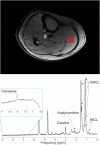Brain and muscle chemistry in myalgic encephalitis/chronic fatigue syndrome (ME/CFS) and long COVID: a 7T magnetic resonance spectroscopy study
- PMID: 40652046
- PMCID: PMC12532701
- DOI: 10.1038/s41380-025-03108-8
Brain and muscle chemistry in myalgic encephalitis/chronic fatigue syndrome (ME/CFS) and long COVID: a 7T magnetic resonance spectroscopy study
Abstract
Myalgic encephalitis/chronic fatigue syndrome (ME/CFS) is a common debilitating medical condition, whose main symptoms - fatigue, post-exertional malaise and cognitive dysfunction - are also present in many cases of long COVID. Magnetic resonance spectroscopy (MRS) allows the insight into their pathophysiology through exploration of a range of biochemicals putatively relevant to aetiological processes, in particular mitochondrial dysfunction and energy metabolism. 24 patients with ME/CFS, 25 patients with long COVID and 24 healthy controls (HC) underwent brain (pregenual and dorsal anterior cingulate cortex, respectively, pgACC and dACC) and calf muscle MRS scanning at 7 Tesla, followed by a computerised cognitive assessment. Compared to HC, ME/CFS patients had elevated levels of lactate in both pgACC and dACC, while long COVID patients had lowered levels of total choline in dACC. By contrast, skeletal muscle metabolites at rest did not significantly differ between the groups. The changes in lactate in ME/CFS are consistent with the presence of energetic stress and mitochondrial dysfunction. A reduction in total choline in long COVID is of interest in the context of the recently reported association between blood clots and 'brain fog', and earlier animal studies showing that choline might prevent intravascular coagulation. Importantly, differences in findings between ME/CFS and long COVID suggest that the underlying neurobiological mechanisms, while leading to similar clinical presentations, may differ. An important implication is that patients with ME/CFS and those with fatigue in the course of long COVID should not be studied as a single group, at least until the mechanisms are better understood.
© 2025. The Author(s).
Conflict of interest statement
Competing interests: BRG has received consultancy fees from Tiefenbacher Pharmaceuticals. Other authors have no conflict of interest to declare.
Figures




References
-
- Prins JB, van der Meer JW, Bleijenberg G. Chronic fatigue syndrome. Lancet. 2006;367:346–55. - PubMed
-
- Rahmati M, Udeh R, Yon DK, Lee SW, Dolja-Gore X, McEVoy M, et al. A systematic review and meta-analysis of long-term sequelae of COVID-19 2-year after SARS-CoV-2 infection: a call to action for neurological, physical, and psychological sciences. J Med Virol. 2023;95:e28852. - PubMed
MeSH terms
Substances
Grants and funding
LinkOut - more resources
Full Text Sources
Medical

